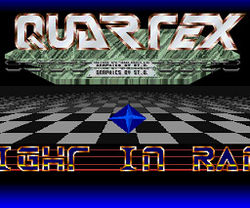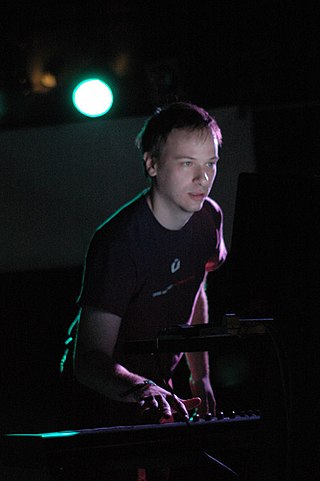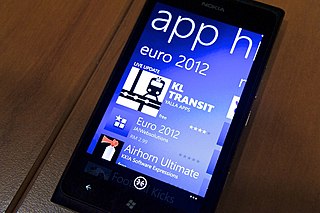
Chiptune is a style of electronic music made using the programmable sound generator (PSG) sound chips or synthesizers in vintage arcade machines, computers and video game consoles. The term is commonly used to refer to tracker format music using extremely basic and small samples that an old computer or console could produce, as well as music that combines PSG sounds with modern musical styles. It has been described as "an interpretation of many genres" since any existing song can be arranged in a chiptune style defined more by choice of instrument and timbre than specific style elements.

A crack intro, also known as a cracktro, loader, or just intro, is a small introduction sequence added to cracked software. It aims to inform the user which "cracking crew" or individual cracker removed the software's copy protection and distributed the crack.

Future Crew was a Finnish demogroup that created PC demos and software, active mostly between 1987 and 1994.

The MOS Technology 6581/8580 SID is the built-in programmable sound generator chip of the Commodore CBM-II, Commodore 64, Commodore 128, and MAX Machine home computers.
A ringtone is the sound made by a telephone to indicate an incoming telephone call. Originally referring to the sound of electromechanical striking of bells or gongs, the term refers to any sound by any device alerting of an incoming call.

The N-Gage is a smartphone combining features of a mobile phone and a handheld game system developed by Nokia, announced on 4 November 2002 and released on 7 October 2003. It runs the original Series 60 platform on Symbian OS v6.1.
Timothy John Follin is an English video game music composer, cinematographer, visual effects artist and game developer, who has written tracks for a variety of titles and home gaming systems, including the ZX Spectrum, Commodore 64, Amiga, Atari ST, Nintendo Entertainment System, Mega Drive, Super NES, Game Boy, Dreamcast, Sega Genesis, and PlayStation.

Andrew Gregory Sega, also known as Necros, is an American musician best known for tracking modules in the 1990s demoscene as well as for composing music for several well-known video games. He was a member of the synthpop duo Iris from 2001 until its disbandment in 2021. In 2020, he founded the dark wave duo Hallowed Hearts.

Jonne Valtonen is a Finnish composer, arranger and orchestrator. He is renowned for his contributions in the field of demoscene and tracker music, under the name Purple Motion, and with Future Crew.
The Nokia tune is a phrase from a composition for solo guitar, Gran Vals, composed in 1902 by the Spanish classical guitarist and composer Francisco Tárrega. It has been associated with Finnish corporation Nokia since the 1990s, becoming the first identifiable musical ringtone on a mobile phone; Nokia selected an excerpt to be used as its default ringtone.

The Nokia 7600 is a camera phone developed by Nokia, running on Series 40. The 7600 was announced on 25 September 2003 and was Nokia's second 3G handset after the Nokia 6650. It is notable for its unique radical design.

Windows Phone (WP) is a discontinued mobile operating system developed by Microsoft for smartphones as the replacement successor to Windows Mobile and Zune. Windows Phone featured a new user interface derived from the Metro design language. Unlike Windows Mobile, it was primarily aimed at the consumer market rather than the enterprise market.

The Nokia Lumia 800, which was codenamed 'Sea Ray', is a smartphone that was launched by Nokia on October 26, 2011, at the Nokia World 2011 event. Initially, it operated on Snapdragon S2 processor and Windows Phone 7.5 "Mango" and was the first device manufactured by Nokia to run on the Windows Phone operating system. This marked a significant shift for the company from using Symbian for their smartphones. Upon its original release in November 2011 in Europe, it was Nokia's flagship product and was hence a crucial product for their mobile phone business.

The Nokia Lumia 900 is a Windows Phone-powered smartphone, first unveiled on January 9, 2012, by Nokia at Consumer Electronics Show 2012, where it won the Best Smartphone award in January 2012. The phone has 4G LTE support and was released in April 2012. The Lumia 900 was the flagship smartphone of the Lumia range until the release of its successor, the Lumia 920.

Symphonic Legends – Music from Nintendo was a symphonic tribute concert held in Cologne, Germany on 23 September 2010 by the WDR Rundfunkorchester Köln, featuring video game music from Japanese game developer Nintendo. The concert featured symphonic arrangements found in some of Nintendo's biggest game series, such as Legend of Zelda, Super Mario Bros., Pikmin, F-Zero and Donkey Kong. The concert was produced and directed by Thomas Böcker, with arrangements provided by Finnish composers and musicians Jonne Valtonen and Roger Wanamo, as well as Japanese game music composers Masashi Hamauzu, Hayato Matsuo, Shiro Hamaguchi and German film composer Torsten Rasch.
Microsoft mobile services are a set of proprietary mobile services created specifically for mobile devices; they are typically offered through mobile applications and mobile browser for Windows Phone platforms, BREW, and Java. Microsoft's mobile services are typically connected with a Microsoft account and often come preinstalled on Microsoft's own mobile operating systems while they are offered via various means for other platforms. Microsoft started to develop for mobile computing platforms with the launch of Windows CE in 1996 and later added Microsoft's Pocket Office suite to their Handheld PC line of PDAs in April 2000. From December 2014 to June 2015, Microsoft made a number of corporate acquisitions, buying several of the top applications listed in Google Play and the App Store including Acompli, Sunrise Calendar, Datazen, Wunderlist, Echo Notification Lockscreen, and MileIQ.

Microsoft Mobile Oy was a subsidiary of Microsoft involved in the development and manufacturing of mobile phones. Based in Espoo, Finland, it was established in 2014 following the acquisition of Nokia's Devices and Services division by Microsoft in a deal valued at €5.4 billion, which was completed in April 2014. Nokia's then-CEO, Stephen Elop, joined Microsoft as president of its Devices division following the acquisition, and the acquisition was part of Steve Ballmer's strategy to turn Microsoft into a "devices and services" company. Under a 10-year licensing agreement, Microsoft Mobile held rights to sell feature phones running the S30/S30+ platform under the Nokia brand.
Mark Knight, also known as TDK and Madfiddler, is a British musician, video game music composer and sound designer. He started out writing chiptune and module file music in the Amiga demoscene, and began his games industry career as a composer in 1992. He continued until 2000 when he moved to sound design, and since 2014 has had a split role as a sound designer and composer culminating by going self employed in 2017.

Club Nokia was a mobile internet digital distribution portal, similar to an App Store, operated by Nokia to provide special offers, paid-for ringtones, picture messages and game content directly to members. Following resistance from its mobile operator customers, Nokia partially closed the service and the brand became solely a consumer service and loyalty portal.

Beatnik, Inc., founded as Headspace, Inc., was a company that specialized in interactive audio technology. It was founded by musician Thomas Dolby in 1993 along with co-founder Mary Coller. It is best known for its Beatnik technology, which was used to provide sound in small file sizes on websites and later in billions of phones during the 2000s to play polyphonic ringtones, with its key clients being Nokia, Sony Ericsson, Samsung, and various other manufacturers. During its earlier years it also produced music for video games such as Cyberia and Obsidian.















